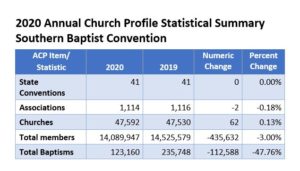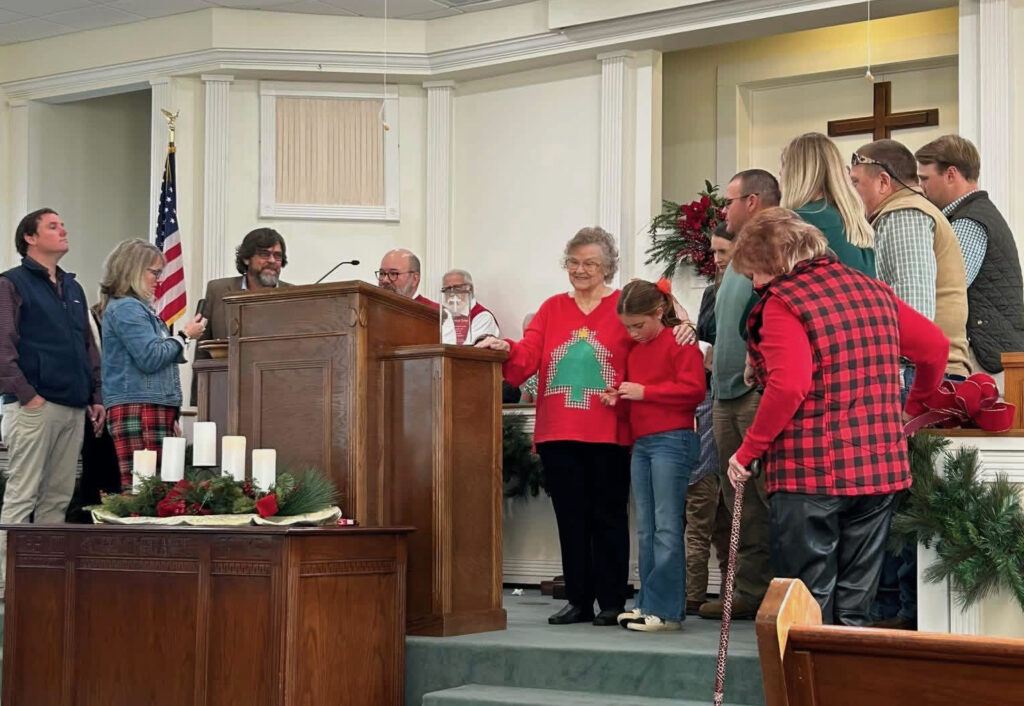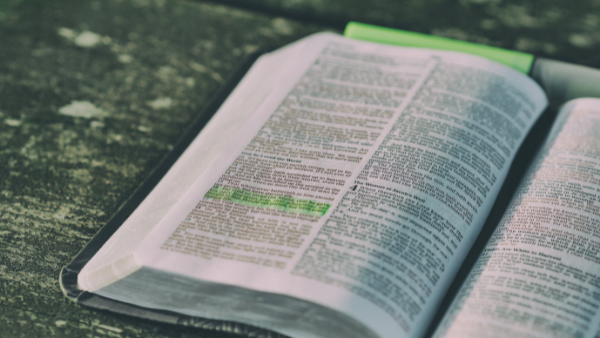In the early weeks and months of the COVID-19 pandemic, many Southern Baptist churches joined the wave of school and business closures to help stem the spread of the coronavirus. Churches shifted to online worship services, while Sunday School classes and small groups met in backyards and via Zoom. While the total impact of COVID-19 on church practices may not be fully known, recent data from the Southern Baptist Convention suggests a significant effect.
According to the latest Annual Church Profile report, the Southern Baptist Convention saw key metrics decline in 2020, including baptisms, membership, average weekly worship attendance, giving and total number of Southern Baptist congregations.
The number of churches cooperating with the SBC increased by 62 to 47,592 or 0.13%. Southern Baptists also reported 3,104 church-type missions last year, a decline of 504 or 13.97%. The number of churches and missions combined is 50,696 congregations. Multisite congregations reported an additional 529 campuses where local church ministry takes place.

Reported membership of those congregations declined by 435,632, down 3 percent to 14 million members. This continues a 14-year trend of membership decline. Membership in Southern Baptist congregations peaked at 16.3 million in 2006, declining more than 2 million since.
Contributing factors
Scott McConnell, executive director of Lifeway Research, said a number of factors likely contributed to the 3 percent decline in overall membership, including fewer congregations, fewer additions through baptism and other additions, likely higher deaths from COVID-19, and other reductions in the membership of individual Southern Baptist congregations.
“Numerous church leaders have described their attempts to stay in touch with their congregation throughout the pandemic,” McConnell said. “As congregations rediscovered the telephone, they also discovered some on their membership lists who moved away, joined another church, or no longer wanted to be a member.”
Attendance
Southern Baptist churches also experienced a decline in worship attendance in 2020. Average weekly worship attendance declined by 15.44% percent to 4.4 million in-person worshippers.
“COVID-19 clearly impacted in-person attendance,” said McConnell. “Throughout much of the year, churches tried to find the right balance of both in-person and online events.”
He noted that congregations were asked to report in-person weekly worship average attendance and in-person Sunday School/Bible study/small group average attendance for the weeks they met in person. “This is consistent with how congregations have been instructed to report in previous years when snowstorms and hurricanes kept congregations from meeting,” said McConnell.
“But COVID-19’s impact extended beyond weeks that congregations could not meet at all,” he said. “When they did meet, the average church saw fewer people attending.”
McConnell said there are strong indicators that worship attendance could rise in 2021. A recent study by Lifeway Research found 91% of Protestant churchgoers plan to attend church in-person as much or more once COVID-19 is no longer an active threat to people’s health.
Baptisms
Southern Baptist congregations reported baptizing 123,160 people in 2020, a 47.76% decline from the 235,748 reported in 2019. This is the 9th straight year with fewer baptisms reported than the prior year.
COVID-19 clearly had an impact on churches’ outreach and evangelism efforts, according to McConnell.
“Socially distant behavior is helpful for containing a pandemic, but it hindered meeting new people, inviting people to church, and helping them take a step of obedience to be baptized,” McConnell said. “The additional outreach through online methods did not make a dent in the smaller number of opportunities to share the gospel in person, including fewer Vacation Bible Schools, live events, and weekly services to invite people to attend. The last year Southern Baptists saw this few people follow Christ for the first time was 1918 and 1919 when the influenza pandemic was sweeping the world.”
McConnell added the decline in baptisms could also be attributed to fewer congregations reporting that data. However, churches who did report showed significant declines in baptisms from the previous year.
Giving and mission expenditures
Total church receipts and undesignated receipts both declined in 2020. Total church receipts reported through the ACP decreased 0.98% percent to 11.5 billion. Undesignated church receipts decreased 0.72% percent to $9.5 billion.
Congregations reported total mission expenditures of $1 billion and Great Commission Giving of $409.8 million.
Giving through the SBC’s Cooperative Program is not included in the ACP statistical summary. Those totals are available through Baptist state conventions and the SBC Executive Committee which processes the mission gifts.
Reporting
According to McConnell, 69% of Southern Baptist churches participated in the ACP in 2020 by reporting at least one item on the profile, down from three-fourths in previous years. However, he said, participation of more than two out of three churches provides reliable information on the impact of COVID-19 on Southern Baptist churches.
“More congregations participated than we expected, showing they value sharing their experience and telling the collective story of Southern Baptists. In this difficult year, state conventions were asked to encourage every congregation to participate but also to be sensitive in making follow-up contacts,” McConnell said.
The ACP is compiled by Lifeway Christian Resources in cooperation with Baptist state conventions. Individual congregations voluntarily report their ACP data to their local Baptist associations and/or their state conventions. National statistics are compiled and released when all cooperating state conventions have reported.
“We knew this was a difficult year for pastors and churches,” McConnell said. “Some of these contacts revealed needs far more important than this survey.”
More information
To download the full summary of the ACP report, click here. To download a state-by-state summary, click here.






Share with others: